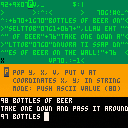This is a Befunge-93 interpreter that I made in a few days. Tested on all examples from Rosetta Code that fit. You can finally code in an esoteric language inside a fantasy console!
Excuse me, what is Befunge?
Befunge is a stack-based, esoteric programming language, in which the code is represented on a two-dimensional grid. The control flow of the program is directed using instructions such as v, >, ^ and < (respectively: down, right, up, left). If a border is reached, the program wraps around (both directions). Single character instructions can pop values of the stack, or place them on top of the stack, and act based on the retrieved values. Read more on Wikipedia.
…what instructions?
Here's the list of all instructions explained, also on Wikipedia. There are not many of them, and most are self-explanatory (arrow instructions, arithmetic operators, numbers). Just like with any other language, the more fun you have with it, the more you'll learn!
…and why should I care?
In my opinion, Befunge really tests (and improves) your logical thinking and flow control skills. This is also a language like no other, in which you can actually visualize the control flow on a grid. Lastly, this is a stack based language, so it teaches you how to operate under a set of limitations (of course, you can just store and read values using g and p instructions, but that's cheating (not really)).
Also, you don't have to care if you don't want to! Democracy!
Okay, maybe some examples?
Sure:
Hello World!
"!dlrow olleh",,,,,,,,,,,,@ |
First, " enables string mode; all characters until next " will be pushed into the stack as ASCII values. Then, the string hello world! is pushed onto the stack (values go bottom to top on the stack). Then , prints a single character, so all characters are printed. Finally, @ ends the program.
Multiply n numbers together
1&>\&*\1-:v ^ _\.@ |
Push 1, then prompt user for n (&, stack: 1 [n]). Swap two top values (\, stack: [n] 1). Prompt user for a number a (stack: [n] 1 [a]), then multiply (*, stack: [n] 1*[a]). Swap values again (stack: 1*[a] [n]), subtract 1 (stack: 1*[a] [n]-1), and if the new value is 0, go right (_), swap values (stack: 0 1*[a]), print number (.) and end the program (@). Otherwise, repeat.
99 Bottles of Beer
92+9*07pv,_ $:|
> >:^:< > 70g!#@_^
^:+670+1g70"bottles of beer on"<
>"selttob"07g1+067+",llaw eht "^
^" of beer"+76"take one down a"<
>"lttob"07g0"dnuora ti ssap dn"^
^"es of beer on the wall!"+76 <
vp70.:-1< |
Sadly, I made this one myself. I'll let you figure this one out. Most important aspects of this code:
- 07p stores the top value in cell (0,7), 07g retrieves it
- +67 is 6+7=13 == "\r", carriage return, which is a newline in PICO-8
- a 0 is always appended after bottle count, that is to be able to discern if a character or a number should be printed
- going past grid borders wraps around
Features:
- Visualization! See the instruction pointer move and wiggle as the code is being executed!
- Load/save support! And it autosaves when you run! And it apparently also works in the browser!
- Hints! Find out what a certain instruction does by hovering over it with the cursor!
- It just works! I'm surprised that it really works, and it works good!
- You can't copy/paste code in or out! This is a nightmare!
- Procedural sound! Instructions make little bleeps when they are being executed, and so do your keys! Doesn't seem to work in the browser! Family fun!
If you want to share your code, you can either share a screenshot, or you can copy the save file, which should be in your usual PICO-8 cart location under the name _picofunge_save.p8. Interwebz!
How to use:
All the usual ASCII characters from your keyboard work, so just poke the interpreter in any way you want!
Use arrow keys to navigate the grid. Use Backspace to erase an instruction and go back one cell, or Space to go forward.
Use Tab to quickly run code. You can also use the Tab button as an alternative for Enter in situations where you would normally use the latter, since Enter opens the pause menu.
Use Enter to enter the pause menu, in which you'll find the following options:
- RUN/STOP CODE
- SAVE
- CLEAR GRID
- ENABLE/DISABLE AUTOSAVE
- ENABLE/DISABLE SOUND
To reload code, restart the cart. There is no LOAD button, since there are only 5 menu items available to me :(
Limitations/known bugs/quirks:
- Backspace button doesn't work in the browser (tested in Firefox)
- If the p instruction is used to put a nonprintable (value outside of ASCII) character in the grid, the character is displayed in a distinct way as a "glitch", it is considered data, and is not saved
- The P key opens up the main menu, which can be sometimes annoying, but is not otherwise a problem
- The grid is smaller than usual Befunge (it's size is 32 columns and 8 rows)
- There is currently no support for big numbers, numbers inside the interpreter are normal PICO-8 numbers (so usual things like integer overflow can happen)
- Small ASCII character codes assumed for letters, since PICO-8 only supports one case.
Bug reports
If you encounter any bugs or weird behaviour, please let me know either in this thread or on Twitter @szczm_. Bonus points for including a screenshot!
Source code, or "how can I make this about me"
If you have any ideas on how you could use this project, the source code is extensively documented — each function and class is explained and I tried to comment every important bit that needed explanation or description. This cart is released under a CC4-BY-NC-SA licence on this website thanks to an upload option, and this is also released on GitHub under the MIT licence. Basically, do anything you want with it, if you want to, and I'll be happy if you let me know!
Last question — why?
Please don't ask.

I'm impressed by your cart and just a little bit disgusted by the language. The Wikipedia page said the language was designed to be hard to write a compiler for, but it seems you had relatively little trouble writing an interpreter.

Thanks! Well, I always understood it that it was hard to write a compiler, not an interpreter, and looking at how the language came out around 1993, maybe the creator thought that it was difficult back then — especially considering that Befunge has self-modifying abilities.

Is there any way to remove the lack of copy/paste feature? It really is a nightmare!
This is super cool though.

Thanks a lot <3 It's been quite a while since I touched this project, or PICO for that matter, but since 0.2.0 just came out, I'll gladly get my hands dirty again and look into it.
[Please log in to post a comment]









